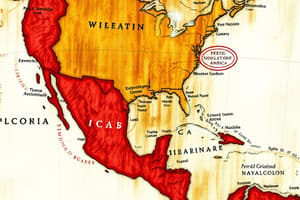Podcast
Questions and Answers
What event marked the beginning of European exploration and colonization in the Americas?
What event marked the beginning of European exploration and colonization in the Americas?
- The establishment of St. Augustine
- The Pueblo Revolt
- The Treaty of Tordesillas
- Christopher Columbus's arrival in 1492 (correct)
Which of the following was a primary motivation behind the Spanish exploration in the New World?
Which of the following was a primary motivation behind the Spanish exploration in the New World?
- Establishing democratic governance
- Contributing to the silk trade
- Seeking religious freedom for settlers
- Pursuing the '3G's: God, Gold, and Glory' (correct)
What was the significance of the Treaty of Tordesillas in 1494?
What was the significance of the Treaty of Tordesillas in 1494?
- It established the first European settlement in the Americas.
- It marked the end of the Spanish and Portuguese War.
- It set terms for the abolition of the slave trade.
- It divided the newly discovered lands outside Europe between Spain and Portugal. (correct)
What was a consequence of the Columbian Exchange?
What was a consequence of the Columbian Exchange?
What was the primary economic focus of French exploration in North America during the early 1600s?
What was the primary economic focus of French exploration in North America during the early 1600s?
Flashcards
Iroquois Confederacy
Iroquois Confederacy
A powerful alliance of six Native American nations in present-day New York state, known for its political structure and influence.
Treaty of Tordesillas
Treaty of Tordesillas
A treaty signed in 1494 between Spain and Portugal, dividing the newly discovered lands in the Americas between them.
Columbian Exchange
Columbian Exchange
A massive exchange of plants, animals, diseases, and cultures between the Old World (Europe, Asia, Africa) and the New World (Americas) following Columbus' voyages.
Smallpox
Smallpox
Signup and view all the flashcards
Triangular Trade
Triangular Trade
Signup and view all the flashcards
Study Notes
AP US History Period 1 (1491-1607)
- Period 1 covers the period in US history from 1491 to 1607, focusing on pre-Columbian societies, European exploration, and colonization.
- Native American Tribes (1491): A diverse range of tribes existed across the continent, each with distinct cultures and societies. Detailed maps show specific tribal locations and names.
- Iroquois Confederacy (c. 1650): A powerful alliance of several Native American tribes in the northeastern part of the continent.
- European Exploration and Colonization (1492): European powers, principally Spain and Portugal, began exploring and colonizing the Americas, leading to contact with Native American societies.
- Treaty of Tordesillas (1494): A treaty dividing newly discovered territories between Spain and Portugal.
- Columbian Exchange (1492-1700): The exchange of plants, animals, diseases, and people between the Americas and Europe, Africa, and Asia. A map illustrates this exchange. Key examples include the transfer of tomatoes, potatoes, corn, and diseases like smallpox to the Old World, and horses, cattle, and various European crops to the Americas.
- Smallpox: A devastating disease brought by Europeans to the Americas, which decimated Native American populations. An illustration depicts the disease's effects.
- The Triangular Trade: A system of trade that connected Europe, Africa, and the Americas. Slaves were transported from Africa to the Americas, while goods were exchanged between the continents. A map illustrates this system.
- The Middle Passage: The brutal journey of enslaved people across the Atlantic Ocean. A graphic representation of conditions during this voyage.
- Spanish Exploration and Conquest (1500s): Spanish conquistadors explored and established colonies in the Americas, often violently subjugating and exploiting Native American populations.
- 3 G's: "God, Gold, and Glory": A motivating factor behind European exploration and conquest. These motivations, which were intertwined, usually included religion (God), wealth (Gold), and fame (Glory).
- St. Augustine, Florida (1565): One of the oldest continuously inhabited European settlements in the United States founded by the Spanish.
- Pueblo Revolt (1680): A successful revolt of the Pueblo Indians against Spanish colonization.
- French Exploration (1608): Focus on fur trade. French explorers established settlements in Canada.
- French Established New Orleans (1718): French establishment of New Orleans, significant for the expansion of the French empire in North America.
- Dutch Exploration (1609): The Dutch formed settlements; their endeavors were primarily about commerce.
- Roanoke or “The Lost Colony” (1585): An early English settlement that mysteriously disappeared.
- Contact's Impact on Native American Societies: European contact caused significant changes to Native American societies. Items brought about the Columbian exchange, disease, and slavery.
- Native American Resistance: Native Americans resisted European encroachment and attempts to change their societies in various ways.
Analysis of Contact Between Native Americans and Europeans
(Questions from the last page)
- Changes in Native American Societies: European contact led to changes in Native American societies. Examples include the adoption of European technology like farming implements and weaponry and cultural blending, which impacted their economies and livelihoods.
- Another Example of Change: Shift in political structures as tribes attempted to form alliances or negotiate with Europeans, leading to changes in their leadership and governing systems.
- Examples of Native American Resistance: One example of resistance is the Pueblo Revolt of 1680. This revolt demonstrates the willingness of Native American communities to fight back against European oppression.
Studying That Suits You
Use AI to generate personalized quizzes and flashcards to suit your learning preferences.



